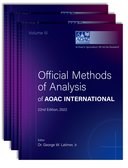 Official Methods of Analysis of AOAC INTERNATIONAL (22nd Edition)
Official Methods of Analysis of AOAC INTERNATIONAL (22nd Edition)
Contents
17.9.34
AOAC Official Method 2007.02
Salmonella spp. in Select Foods: GeneQuence® Salmonella
DNA Hybridization with 24 h Enrichment
Get access
-
Published:January 2023
Cite
Salmonella spp. in Select Foods: GeneQuence® Salmonella
DNA Hybridization with 24 h Enrichment', in Dr. George W Latimer, Jr. (ed.), Official Methods of Analysis of AOAC INTERNATIONAL, 22nd Edition (
Extract
First Action 2007
Final Action 2010
(Applicable to the detection of Salmonella spp. in raw turkey, dried, liquid, and liquid frozen pasteurized eggs, milk chocolate, and dry pet food.)
See Table 2007.02 for results of the interlaboratory study supporting acceptance of the method.
Interlaboratory study results for the detection of Salmonella spp. in foods by the GeneQuence Salmonella assay
...
Caution: Reagents are for laboratory use only. Use of this test should be restricted to personnel with appropriate laboratory training in microbiology. Handle and dispose of enrichment cultures as potentially infectious material. Use either a disposable pipet and pipetting bulb or micropipet with disposable tips to make all pipetting transfers. Do not mouth pipet. The preferred method for disposal of contaminated materials, including cultures, pipets, etc., is autoclaving. Stop solution contains 4 N sulfuric acid. Hybridization solution contains formamide. Avoid contact with skin and mucous membranes.
Principle
The GeneQuence Salmonella assay is a sandwich DNA hybridization (DNAH) assay for detection of Salmonella spp. in select foods. Following culture enrichment of test samples, bacteria present in the culture are lysed to release ribosomal RNA (rRNA). Horseradish peroxidase (HRP)-labeled detector probes and polydeoxyadenylic acid (dA)-labeled capture probes hybridize to Salmonella-specific sequences of the rRNA. The dA tail on the capture probe facilitates binding of the hybridized complex to a polydeoxythymidylic acid (dT)-coated microwell. Unbound probe is removed by washing, and a chromogenic substrate of HRP is added. After color development, the reaction is stopped by the addition of acid, and absorbance at 450 nm is determined using a photometer. Absorbance in excess of a threshold value indicates the presumptive presence of Salmonella spp. in the sample. A positive result must be confirmed by standard culture procedures such as those described in the U.S. Department of Agriculture’s Food Safety and Inspection Service [USDA-FSIS; U.S. Department of Agriculture-Food Safety Inspection Service (2004) Microbiology Laboratory Guidebook, Ch. 4, http://www.fsis.usda.gov/PDF/MLG_4_03.pdf] and the U.S. Food and Drug Administration’s Bacteriological Analytical Manual [FDA/BAM; U.S. Food and Drug Administration (2003) Bacteriological Analytical Manual Online, Ch. 5, http://www.cfsan.fda.gov/~ebam/bam-5.html] reference methods.
Sign in
Personal account
- Sign in with email/username & password
- Get email alerts
- Save searches
- Purchase content
- Activate your purchase/trial code
- Add your ORCID iD
Purchase
Our books are available by subscription or purchase to libraries and institutions.
Purchasing information| Month: | Total Views: |
|---|---|
| May 2024 | 1 |
| June 2024 | 2 |
| July 2024 | 9 |
| August 2024 | 2 |
| September 2024 | 2 |
| November 2024 | 7 |
| December 2024 | 7 |
| February 2025 | 5 |
| March 2025 | 3 |
| April 2025 | 5 |




Get help with access
Institutional access
Access to content on Oxford Academic is often provided through institutional subscriptions and purchases. If you are a member of an institution with an active account, you may be able to access content in one of the following ways:
IP based access
Typically, access is provided across an institutional network to a range of IP addresses. This authentication occurs automatically, and it is not possible to sign out of an IP authenticated account.
Sign in through your institution
Choose this option to get remote access when outside your institution. Shibboleth/Open Athens technology is used to provide single sign-on between your institution’s website and Oxford Academic.
If your institution is not listed or you cannot sign in to your institution’s website, please contact your librarian or administrator.
Sign in with a library card
Enter your library card number to sign in. If you cannot sign in, please contact your librarian.
Society Members
Society member access to a journal is achieved in one of the following ways:
Sign in through society site
Many societies offer single sign-on between the society website and Oxford Academic. If you see ‘Sign in through society site’ in the sign in pane within a journal:
If you do not have a society account or have forgotten your username or password, please contact your society.
Sign in using a personal account
Some societies use Oxford Academic personal accounts to provide access to their members. See below.
Personal account
A personal account can be used to get email alerts, save searches, purchase content, and activate subscriptions.
Some societies use Oxford Academic personal accounts to provide access to their members.
Viewing your signed in accounts
Click the account icon in the top right to:
Signed in but can't access content
Oxford Academic is home to a wide variety of products. The institutional subscription may not cover the content that you are trying to access. If you believe you should have access to that content, please contact your librarian.
Institutional account management
For librarians and administrators, your personal account also provides access to institutional account management. Here you will find options to view and activate subscriptions, manage institutional settings and access options, access usage statistics, and more.